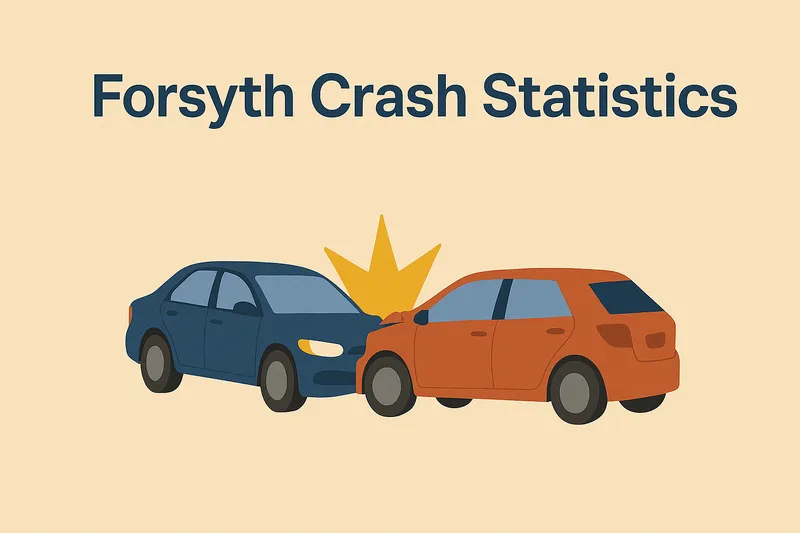Forsyth County Crash Statistics and Distracted Driving Trends
3/29/2025 | Written by Elliot Bourne

Over the past five years, Forsyth County, Georgia has seen several thousand traffic crashes annually, with a significant downturn in 2020 (likely due to pandemic impacts) followed by a rebound in 2021–2022.
Trends: Forsyth County’s crashes hit a low in 2020 with about 5,228 crashes (down from ~7,383 in 2018). Since then, crashes have risen again, reaching 6,726 crashes in 2022. The number of crashes involving injuries shows a similar dip in 2020 (about 1,144 injury crashes in 2020 vs ~1,450+ in other years). Notably, fatal crashes have increased in recent years – from 13 in 2019 and 2020 up to 24 fatal crashes in 2022. This upward shift in fatalities aligns with statewide trends of rising roadway deaths in the late pandemic/post-pandemic period.
Forsyth County Crash Statistics (2018–2022)
| Year | Total Crashes | Injury Crashes | Fatal Crashes (Fatalities) |
|---|---|---|---|
| 2018 | 7,383 | 1,627 | 18 (18) |
| 2019 | 6,584 | 1,451 | 13 (13) |
| 2020 | 5,228 | 1,144 | 13 (13) |
| 2021 | 6,102 | 1,440 | 20 (20) |
| 2022 | 6,726 | 1,459 | 24 (24) |
Distracted Driving Statistics & Trends in Georgia (with Forsyth County Highlights)
Distracted driving – especially mobile phone use behind the wheel – is a leading contributor to crashes in Georgia. The use of phones while driving remains the predominant form of distraction and has prompted legislative and enforcement efforts (e.g. Georgia’s 2018 Hands-Free Law). Statewide data show that over half of all crashes involve driver distraction. In fact, a recent analysis found 53% of all motor vehicle crashes in Georgia in 2022 involved at least one confirmed or suspected distracted driver. This is a slight decrease from 2019, when about 56% of crashes were distraction-related, but an increase from the pandemic-affected year 2020 (when the share dipped to ~47% amid lighter traffic). By 2021–2022, distraction was again a factor in roughly half of crashes statewide. (For example, 54% in 2021 and 53% in 2022 involved distracted driving.) The data underscore that distracted driving is pervasive on Georgia roads.
Observation: A 2023 roadside observational survey found nearly 1 in 5 drivers (19.6%) in Georgia was observed engaging in some form of distraction (e.g. talking or texting on a phone, eating, etc.) at any given time. In other words, at least 20% of drivers are distracted during typical daytime travel in Georgia. Hand-held device use (phone calls or texting) was a large subset of this distraction and was observed at higher rates on weekdays (when drivers are commuting) than weekends.
Phone Use and the Hands-Free Law
Georgia’s Hands-Free Law (effective July 1, 2018) made it illegal for drivers to hold or support a phone while driving. In the 18 months following enactment, enforcement ramped up dramatically – the number of distracted driving convictions processed by Georgia’s Department of Driver Services increased 5.5× (from 965 convictions in July 2018 to 5,344 in December 2019). Statewide, distracted driving citations skyrocketed in 2019, with over 65,000 convictions in 2019 (up from ~25,600 in 2018). This was followed by a sharp drop in 2020 (just over 31,000 convictions) as traffic enforcement and court activity were curtailed during COVID-19. In subsequent years, citations rose again – about 43,800 convictions in 2021 and 48,800 in 2022 for distracted driving statewide. In 2022 alone, nearly 49,000 distracted driving convictions were processed in Georgia, reflecting continued efforts to enforce the hands-free law. The sustained high volume of tickets indicates that phone use while driving remains widespread, and tackling this behavior is an ongoing challenge.
Who is most involved?
Young drivers are especially prone to distracted-driving crashes. Drivers age 15–24 (who represent only 15% of Georgia’s licensed drivers) were involved in 26% of all distraction-related crashes in 2022. They also accounted for nearly one-third of all distracted driving citations issued after crashes. This over-involvement of youth is an important trend, as it suggests outreach and enforcement efforts are particularly needed for younger motorists. Additionally, distracted driving puts not only the driver at risk but also others on the road – more than three-fourths of distraction-related crashes in Georgia involve another vehicle or road user, and about 13% of those killed or seriously injured in distraction-related crashes are pedestrians or bicyclists. This indicates that the consequences of texting or other inattention can be deadly for bystanders as well as the drivers themselves.
Forsyth County Distracted Driving:
Forsyth County’s distracted driving patterns generally mirror the statewide situation. In fact, Forsyth has a slightly higher incidence of distraction in crashes than the state average. In 2022, an estimated 58% of all crashes in Forsyth County involved a distracted driver, compared to 53% statewide. This local proportion has been in the same range (roughly half of crashes) in recent years. When looking at the most serious crashes, distraction is a significant factor but not the top cause. Between 2018 and 2022, about 9% of Forsyth County’s fatal and serious-injury crashes were attributed to distracted driving. (This is somewhat below the distraction contribution for Georgia as a whole, which was about 11% of severe crashes in that period.) Still, distracted driving is a major contributor to Forsyth’s crash totals. Forsyth County joined the Atlanta Regional Commission in 2021, and like many metro-Atlanta counties (which tend to have higher traffic volumes and phone usage rates), it sees a greater share of distraction-related crashes than most rural counties. Local authorities have emphasized anti-distraction campaigns (e.g. ”Hands on Georgia” enforcement waves) to try to curb this behavior.